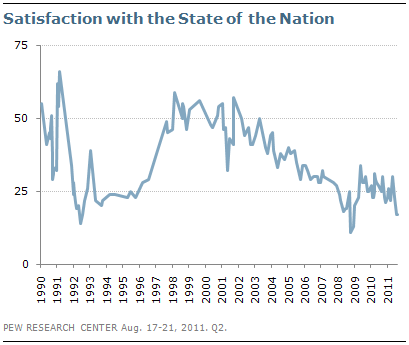Just 7% of Americans say the U.S. economy is in excellent (1%) or good (6%) shape, while 93% say economic conditions are only fair (37%) or poor (56%). Poor ratings of the economy have jumped 10 points from June.
At the same time, about two-thirds of Americans (68%) do not expect the economy to improve in the next year. Half (50%) expect economic conditions to be the same as now in a year’s time and 18% expect conditions to be worse. Just three-in-ten (29%) expect U.S. economic conditions to be better a year from now.
Combined, these figures show the gloomiest economic outlook since the start of the economic downturn. While the economy was clearly seen as in worse shape at times during late 2008 and early 2009, the public was far more optimistic about a turnaround at that time. Today, roughly two-in-three (65%) Americans say the economy is in only fair or poor shape and say it will get no better over the coming year. While little changed from June of this year, this is the highest since the Pew Research Center began asking this combination of questions in early 2004.
Public Less Focused on Deficit Reduction

Americans are now evenly divided over whether the federal government should prioritize spending to help the economy recover or reducing the budget deficit: 47% say spending to help the economy should be the higher priority, while 46% say reducing the budget deficit. In June, 52% viewed reducing the deficit as the higher priority compared with 42% who prioritized spending to help the economy. In February, the public was, as now, more evenly divided.
Democrats remain far more likely to prioritize spending on the economy (61%), than deficit reduction (32%), and their views are largely unchanged from two months ago. But the balance of opinion among independents has shifted markedly. In June, independents prioritized deficit reduction by a 15-point margin (54% vs. 39%). Today, independents are split evenly over this tradeoff (46% deficit reduction, 47% spending to help the economy).

Republicans and Republican leaning independents who agree with the Tea Party movement remain overwhelmingly committed to deficit reduction (82% today, 84% in June). But Republicans and Republican leaners who do not agree with the Tea Party are more divided today than they were in June. Two months ago, they favored deficit reduction over stimulus spending by 33 points (63% to 30%). Today, that margin has narrowed to 15 points (55% to 40%).
Satisfaction Remains Low
Just 17% of Americans are satisfied with the way things are going in the country today, while 79% are dissatisfied. These figures are unchanged from July before the debt-ceiling showdown and ensuing market fluctuations. Satisfaction is now at its lowest point since late 2008.

Older Americans are much less likely to say they are satisfied than are their younger counterparts. Just 5% of those 65 and older say they are satisfied with the state of the nation, compared with 31% of adults under age 30.
Democrats are somewhat more likely to say they are satisfied (21%) than are independents (15%) or Republicans (11%).